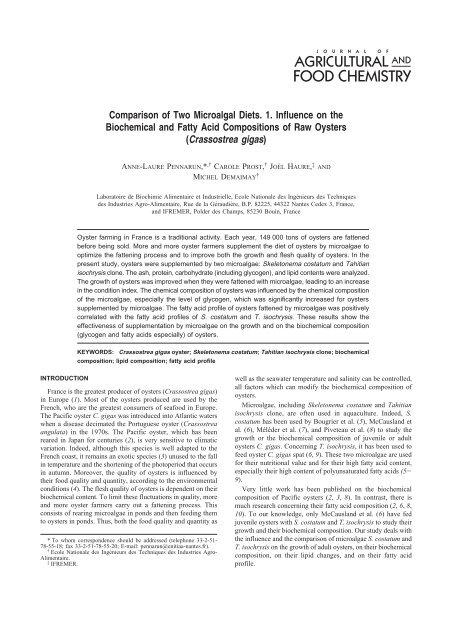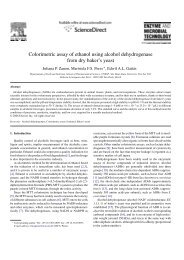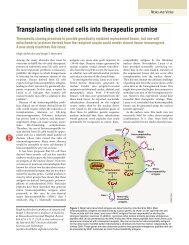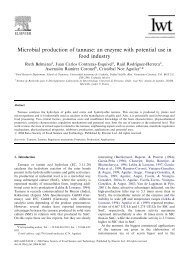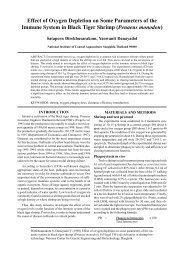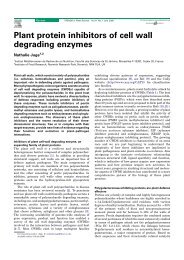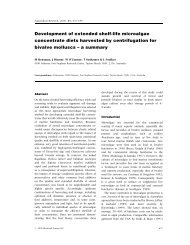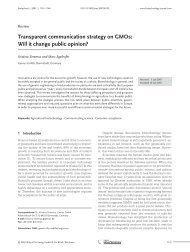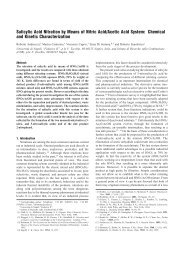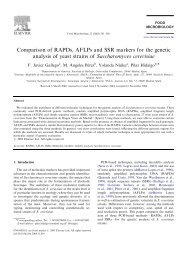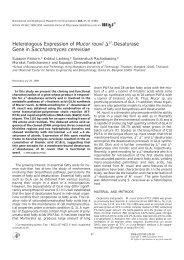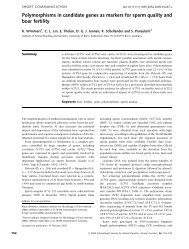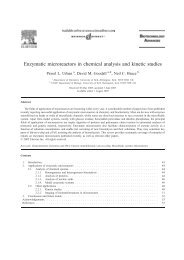Crassostrea giga - Biotechnology
Crassostrea giga - Biotechnology
Crassostrea giga - Biotechnology
You also want an ePaper? Increase the reach of your titles
YUMPU automatically turns print PDFs into web optimized ePapers that Google loves.
INTRODUCTION<br />
Comparison of Two Microalgal Diets. 1. Influence on the<br />
Biochemical and Fatty Acid Compositions of Raw Oysters<br />
(<strong>Crassostrea</strong> <strong>giga</strong>s)<br />
ANNE-LAURE PENNARUN,* ,† CAROLE PROST, † JOËL HAURE, ‡ AND<br />
MICHEL DEMAIMAY †<br />
Laboratoire de Biochimie Alimentaire et Industrielle, Ecole Nationale des Ingénieurs des Techniques<br />
des Industries Agro-Alimentaire, Rue de la Géraudière, B.P. 82225, 44322 Nantes Cedex 3, France,<br />
and IFREMER, Polder des Champs, 85230 Bouin, France<br />
Oyster farming in France is a traditional activity. Each year, 149 000 tons of oysters are fattened<br />
before being sold. More and more oyster farmers supplement the diet of oysters by microalgae to<br />
optimize the fattening process and to improve both the growth and flesh quality of oysters. In the<br />
present study, oysters were supplemented by two microalgae: Skeletonema costatum and Tahitian<br />
isochrysis clone. The ash, protein, carbohydrate (including glycogen), and lipid contents were analyzed.<br />
The growth of oysters was improved when they were fattened with microalgae, leading to an increase<br />
in the condition index. The chemical composition of oysters was influenced by the chemical composition<br />
of the microalgae, especially the level of glycogen, which was significantly increased for oysters<br />
supplemented by microalgae. The fatty acid profile of oysters fattened by microalgae was positively<br />
correlated with the fatty acid profiles of S. costatum and T. isochrysis. These results show the<br />
effectiveness of supplementation by microalgae on the growth and on the biochemical composition<br />
(glycogen and fatty acids especially) of oysters.<br />
KEYWORDS: <strong>Crassostrea</strong> <strong>giga</strong>s oyster; Skeletonema costatum; Tahitian isochrysis clone; biochemical<br />
composition; lipid composition; fatty acid profile<br />
France is the greatest producer of oysters (<strong>Crassostrea</strong> <strong>giga</strong>s)<br />
in Europe (1). Most of the oysters produced are used by the<br />
French, who are the greatest consumers of seafood in Europe.<br />
The Pacific oyster C. <strong>giga</strong>s was introduced into Atlantic waters<br />
when a disease decimated the Portuguese oyster (<strong>Crassostrea</strong><br />
angulata) in the 1970s. The Pacific oyster, which has been<br />
reared in Japan for centuries (2), is very sensitive to climatic<br />
variation. Indeed, although this species is well adapted to the<br />
French coast, it remains an exotic species (3) unused to the fall<br />
in temperature and the shortening of the photoperiod that occurs<br />
in autumn. Moreover, the quality of oysters is influenced by<br />
their food quality and quantity, according to the environmental<br />
conditions (4). The flesh quality of oysters is dependent on their<br />
biochemical content. To limit these fluctuations in quality, more<br />
and more oyster farmers carry out a fattening process. This<br />
consists of rearing microalgae in ponds and then feeding them<br />
to oysters in ponds. Thus, both the food quality and quantity as<br />
* To whom correspondence should be addressed (telephone 33-2-51-<br />
78-55-18; fax 33-2-51-78-55-20; E-mail: pennarun@enitiaa-nantes.fr).<br />
† Ecole Nationale des Ingénieurs des Techniques des Industries Agro-<br />
Alimentaire.<br />
‡ IFREMER.<br />
well as the seawater temperature and salinity can be controlled,<br />
all factors which can modify the biochemical composition of<br />
oysters.<br />
Microalgae, including Skeletonema costatum and Tahitian<br />
isochrysis clone, are often used in aquaculture. Indeed, S.<br />
costatum has been used by Bougrier et al. (5), McCausland et<br />
al. (6), Méléder et al. (7), and Piveteau et al. (8) tostudythe<br />
growth or the biochemical composition of juvenile or adult<br />
oysters C. <strong>giga</strong>s. Concerning T. isochrysis, it has been used to<br />
feed oyster C. <strong>giga</strong>s spat (6, 9). These two microalgae are used<br />
for their nutritional value and for their high fatty acid content,<br />
especially their high content of polyunsaturated fatty acids (5-<br />
9).<br />
Very little work has been published on the biochemical<br />
composition of Pacific oysters (2, 3, 8). In contrast, there is<br />
much research concerning their fatty acid composition (2, 6, 8,<br />
10). To our knowledge, only McCausland et al. (6) have fed<br />
juvenile oysters with S. costatum and T. isochrysis to study their<br />
growth and their biochemical composition. Our study deals with<br />
the influence and the comparison of microalgae S. costatum and<br />
T. isochrysis on the growth of adult oysters, on their biochemical<br />
composition, on their lipid changes, and on their fatty acid<br />
profile.
MATERIALS AND METHODS<br />
Reagents. Butylated hydroxytoluene, nonadecanoic acid, trifluoroboride/methanol<br />
(14%), and glucose standard solution at 100 mg/dL<br />
were obtained from Sigma-Aldrich (Germany). Hexane, toluene, phenol,<br />
trichloroacetic acid, sodium hydroxide, anhydrous sodium carbonate,<br />
Folin-Ciocalteau reagent, and bovine albumin were purchased from<br />
Merck (Germany). Acetone, anhydrous sodium sulfate, sulfuric acid,<br />
copper sulfate, and sodium-potassium tartrate were purchased from<br />
Panreac (Spain). Chloroform was purchased from Cluzeau (France).<br />
Oysters. Oysters C. <strong>giga</strong>s were obtained from the Bay of Bourgneuf<br />
in Vendée on the Atlantic coast of Western France. Oysters were<br />
collected outside the maturation period, from January to March 2001,<br />
at the adult stage. After collection, they were stored alive at 4 °C for<br />
6days.<br />
Microalgae. Microalgae S. costatum, which is a diatom, was reared<br />
outside in an 80 000-L pond with underground saltwater, the composition<br />
of which was given by Baud (11). Natural light was used for<br />
photosynthesis. The temperature varied from 15 to 17 °C, depending<br />
on the climatic conditions, and the saltwater salinity was 33-34 g/L.<br />
The flagellate T. isochrysis was grown in a 300-L tank containing<br />
underground saltwater and vitamin B12, in a special room at 22 °C.<br />
Photosynthesis was assured by artificial light. The salinity of the<br />
saltwater was 33-34 g/L.<br />
Oysters’ Diet. The experiments took place in Bouin in the Bay of<br />
Bourgneuf. Three 600-L plastic tanks containing 400 oysters were<br />
supplied by seawater at 14 °C. In the first tank (oyster control group),<br />
oysters were fed only with natural phytoplankton contained in seawater<br />
containing about 2 µg/L of particulate organic matter (POM). In the<br />
second and third tanks, oysters were fed with seawater enriched with<br />
S. costatum (4.8 mg of POM/L) and T. isochrysis (5.1 mg of POM/L),<br />
respectively. The content of organic matter in the tank was measured<br />
by weighing a Whatman filter GF/C in which a known volume (V) of<br />
microalgae was filtered. The filter was rinsed with ammonium formate,<br />
dried at 56 °C for 24 h, and then weighed (P1). The filter was then<br />
calcined at 450 °C for1handweighed(P2). The POM was calculated<br />
as follows: POM (mg/L) ) 1000 × (P1 - P2)/V. In terms of cells,<br />
2 × 10 9 cells of S. costatum per oyster per day and 8 × 10 9 cells of T.<br />
isochrysis per oyster per day were given to oysters. The cells were<br />
counted with a scanner using a Malassez cell (0.0025 mm 2 area × 0.2<br />
mm depth). Seawater salinity, temperature, and oxygen content were<br />
measured regularly. Seawater salinity was measured using a conductivity<br />
meter (WTW, USA). Oxygen content was determined using a<br />
dissolved oxygen meter (WTW). An oxygenation ramp allowed the<br />
oysters to be oxygenated, and the mixing of the seawater column<br />
permitted a good distribution of the microalgae in the tank. Seawater<br />
was renewed at a rate of 600 L h -1 tank -1 .<br />
The experiment lasted 6 weeks. Oysters were sampled at time 0<br />
and after 6 weeks of experimentation for all the analyses.<br />
Condition Index. The growth of the oysters was evaluated through<br />
the determination of their condition index. The condition index was<br />
evaluated on 30 oysters by measuring the whole weight of oysters and<br />
their flesh weight. This index was measured in order to evaluate how<br />
the oyster used the internal cavity volume for the development of its<br />
tissues. The condition index is calculated as CI ) (Wf × 100)/Wt, where<br />
CI is the condition index, Wf is the flesh weight of the oyster, and Wt<br />
is the total weight of the oyster (AFNOR). The condition index can<br />
vary from 6 to 9, according to the quality of the oysters. In our study,<br />
oysters at the beginning of the experiment had a condition index of<br />
6.7.<br />
Biochemical Analyses. Thirty freeze-dried oysters were crushed to<br />
a fine powder. The protein content of 8 mg of oyster powder was<br />
measured in triplicate by the colorimetric method described by Lowry<br />
et al. (12). The carbohydrate and glycogen contents of 5 mg of oyster<br />
powder were determined in triplicate by the method of Dubois et al.<br />
(13). Lipids of oysters and of microalgae (S. costatum and T. isochrysis)<br />
were extracted by a mixture of chloroform/methanol (2:1, v/v) using<br />
the method of Folch et al. (14), and their content was measured by a<br />
gravimetric method. Thirty oysters were crushed, and six lipid<br />
extractions were made on 10 g of the crushed mixture. The lipid<br />
contents of 50 g of S. costatum and20gofT. isochrysis pastes were<br />
Table 1. Biochemical Composition of Oysters of the Control Groups<br />
and Those Fed S. costatum and T. isochrysis after 6 Weeks of<br />
Experimentation<br />
OCG-S0 OCG-S6 OS−S6 OI−S6<br />
condition index a 6.7 (1.6) a 7.2 (1.1) a 9.4 (1.6) a 8.2 (1.6) a<br />
ash b (% dry matter) 24.6 (2.3) a 29.6 (2.1) b 20.8 (0.9) c 25.9 (0.9) a<br />
protein b (% dry matter) 49.0 (1.3) a 40.3 (1.9) b 36.4 (1.9) c 37.6 (2.2) bc<br />
carbohydrate b (% dry matter) 15.0 (0.1) a 21.7 (4.1) b 32.2 (0.3) c 34.0 (3.8) c<br />
glycogen b (% dry matter) 7.4 (0.1) a 9.7 (1.7) b 29.9 (0.1) c 23.2 (1.4) d<br />
lipid c (% dry matter) 8.5 (1.1) a 7.9 (0.3) a 11.1 (0.8) b 9.9 (0.1) c<br />
a OCG, oyster control group; OS, oysters supplemented by S. costatum; OI,<br />
oysters supplemented by T. isochrysis; S0, control point; S6, level after 6 weeks<br />
of experimentation. b Mean (tandard deviation), n ) 30. c Mean (standard deviation),<br />
n ) 3. d Mean (standard deviation), n ) 6. Values in the same row followed by<br />
different letters are significantly different by ANOVA (p < 0.05).<br />
determined in triplicate. The microalgae pastes were obtained by<br />
centrifugation of the particles in suspension in the underground<br />
saltwater.<br />
Fatty Acid Analyses. The composition of fatty acids in oysters and<br />
in the two microalgae was determined by gas chromatography after<br />
their transmethylation by a mixture of trifluoroboride/methanol (14%),<br />
as described by Morrison and Smith (15). The fatty acid methyl esters<br />
(FAMEs) were analyzed by using a gas chromatograph (HP model 5890<br />
series II chromatograph, Hewlett-Packard Co., Palo Alto, CA). One<br />
microliter of extract was injected in a split mode on an injector set at<br />
250 °C. The FAMEs were separated on a capillary column (DB-23,<br />
30 m length × 0.25 mm i.d. × 0.25 µm thickness, J&W Scientific,<br />
Folsom, CA). The oven temperature was set at 150 °C for3minand<br />
then increased at a rate of 10 °C/min to 180 °C for 7 min, followed by<br />
a further increase at a rate of 5 °C/min to 215 °C, with a final time of<br />
15 min. The helium carrier gas flow was 1 mL/min. The detector was<br />
a flame ionization detector set at 280 °C. Nonadecanoic acid (2 mg)<br />
was used to quantify the FAMEs. A commercial solution of standards<br />
(Sigma Chemical Co., Saint Louis, MO) was injected in order to identify<br />
FAMEs on the basis of their retention index. The identification of<br />
FAMEs was confirmed by using a gas chromatograph (HP 5890 II,<br />
Hewlett-Packard Co.) coupled with a mass spectrometer equipped with<br />
an electronic impact source (HP 5971 II mass-selective detector,<br />
Hewlett-Packard Co.). The temperatures of the oven and of the injector<br />
were the same as previously used. The MSD conditions were as follow:<br />
ionization energy, 70 eV; mass range, 33-300 u; scan rate, 2.0 scans/<br />
s; electron multiplier voltage, 200 V; interface temperature, 180 °C.<br />
The spectra of FAMEs were compared with those of an internal library<br />
at our laboratory and with a commercial one (NBS 75k).<br />
Statistical Treatment. Data acquisition and statistical treatment<br />
(variance analysis ANOVA) were performed on Statgraph 4.0 software.<br />
RESULTS AND DISCUSSION<br />
Biochemical Composition. Table 1 shows the change in the<br />
biochemical composition of unfed oysters and oysters supplemented<br />
with microalgae. The oyster control group contained<br />
about 90% moisture. The main components of the oysters were<br />
protein (49.0% of dry matter) and ashes (24.6% of dry matter).<br />
They contained 8.5% lipids, and the rest was composed of<br />
carbohydrates including glycogen. The same oysters after 6<br />
weeks at 14 °C in the tank showed a reduced protein content<br />
(from 49.0% to 40.3%) and an increase in carbohydrates (from<br />
15.0% to 21.7%). The fluctuation in the biochemical composition<br />
was probably due to bad weather conditions, which led to<br />
a decrease in the water salinity (24 g/L instead of 33 g/L as<br />
usually found in this region). It may also have been due to a<br />
lack of quality of shellfish in the Bay of Bourgneuf since the<br />
oil pollution by the tanker “Erika” in December 1999. Laing<br />
and Earl (16) have already shown that the level of salinity can<br />
affect oysters, and particularly the metamorphosis of oyster
larvae; however, they do not specify in which sense. According<br />
to our experiment, the decrease of the seawater salinity resulted<br />
in mortality of oysters and their limited growth. Linehan et al.<br />
(2) have shown that seasonal variation has an important impact<br />
on the biochemical composition of oysters. In the same way,<br />
the climatic conditions also have a great importance.<br />
The condition index was increased in oysters supplemented<br />
by microalgae. The condition index was 7.2 for the oyster<br />
control group versus 9.4 and 8.2 respectively for oysters<br />
supplemented by S. costatum and T. isochrysis, showingan<br />
improvement in the growth of oysters. The glycogen content<br />
increased, indicating a good availability and a good assimilation<br />
of microalgae in the habitat. Castell and Trider (17) have shown<br />
a glycogen content increase when oysters are fed both carbohydrates<br />
and lipids. Glycogen is the main energy source of<br />
oysters and plays an essential part in the reproductive cycle (2,<br />
18). The lipid content of oysters fed microalgae increased with<br />
the contribution of the lipids of microalgae. The increase in<br />
lipids in oysters supplemented by S. costatum was higher than<br />
that in oysters supplemented by T. isochrysis. This is in<br />
agreement with the lipid content of the microalgae, which is<br />
6.7 and 4.3% of dry matter for S. costatum and T. isochrysis,<br />
respectively.<br />
Fatty Acid Composition. Table 2 shows the fatty acid<br />
composition of microalgae S. costatum and T. isochrysis and<br />
the fatty acid composition of oysters of the control group and<br />
those supplemented by microalgae at the beginning and after 6<br />
weeks of experimentation. A significant difference in the content<br />
of the fatty acids of the n-9, n-7, n-6, and n-3 series was<br />
observed between the oyster control group at the beginning of<br />
the experiment (week 0) and after 6 weeks of experimentation.<br />
As for the biochemical composition, the climatic variation<br />
changed the fatty acid composition. The fatty acid composition,<br />
however, followed the tendency found by Linehan et al. (2),<br />
McCausland et al. (6), and Piveteau et al. (8). The control group<br />
oysters were mainly composed of saturated fatty acids and<br />
polyunsaturated fatty acids. The main fatty acids in oysters were<br />
palmitic acid (C16:0), eicosapentaenoic acid (C20:5 n-3), and<br />
docosohexaenoic acid (C22:6 n-3). C20:5 n-3 and C22:6 n-3<br />
have been found to be essential fatty acids in oysters (19). An<br />
enriched diet in these last two fatty acids increased the growth<br />
of bivalves (20).<br />
The content of C16:0 in oysters was steady, even with the<br />
supplementation by the microalgae. The diatom S. costatum<br />
contains 27.2% of saturated fatty acids and the flagellate T.<br />
isochrysis 39.5%. No significant difference in saturated fatty<br />
acids content was observed between oysters fed microalgae and<br />
the oyster control group at week 6. Nevertheless, a statistical<br />
difference was observed between oysters fed the two microalgae.<br />
Saturated fatty acids were not accumulated in oysters.<br />
A significant difference was observed for n-9 fatty acid<br />
content, the level of which was 2.7% for oysters supplemented<br />
by S. costatum and 7.3% for oysters supplemented by T.<br />
isochrysis. The difference was due to the presence of C18:1<br />
n-9, high in oysters fattened with T. isochrysis, in agreement<br />
with the content of this fatty acid in the microalgae.<br />
A significant difference (p < 0.05) in n-7 fatty acid content<br />
was observed between oysters supplemented by microalgae<br />
(6.2% for oysters supplemented by S. costatum and 2.8% for<br />
oysters supplemented by T. isochrysis). This is related to the<br />
content of n-7 fatty acid in the microalgae. Indeed, S. costatum<br />
contains 21.3% of n-7 fatty acid (compared to 5.8% for T.<br />
isochrysis). The n-7 fatty acid level increases due to the<br />
accumulation of the C16:1 n-7 of the microalgae, but it could<br />
Table 2. Evolution of Total Fatty Acid Composition of Control Group<br />
Oysters and Those Supplemented by S. costatum and T. isochrysis<br />
after 6 Weeks of Experimentation (in % of the Total Fatty Acid) a<br />
fatty<br />
acid<br />
S.<br />
costatum<br />
microalgae<br />
experimentation time<br />
T.<br />
isochrysis OCG-S0 OS-S6 OCG-S6 OI-S6<br />
statistical<br />
effect<br />
11:0 0.0 (0.0) 0.1 (0.0) 0.0 a 0.1 b 0.1 b 0.1 b *<br />
12:0 1.5 (0.1) 1.9 (0.1) 0.0 a 0.1 b 0.0 a 0.0 a **<br />
13:0 nd nd 0.0 a 0.1 b 0.1 b 0.2 c **<br />
14:0 14.1 (2.2) 24.9 (0.6) 0.3 a 1.7 b 5.2 c 9.7 d ***<br />
15:0 0.5 (0.1) 0.6 (0.1) 1.2 a 0.5 b 0.3 c 0.4 b c *<br />
16:0 10.7 (1.7) 11.0 (0.3) 26.9 a 22.5 b c 21.2 c 24.0 b **<br />
17:0 nd 0.2 (0.1) 0.1 a 4.0 b 2.0 c 2.7 d **<br />
18:0 0.3 (0.1) 0.5 (0.1) 1.1 a 7.3 b 5.1 c 4.4 d **<br />
20:0 0.1 (0.0) 0.3 (0.1) 0.1 0.2 0.2 0.1 ns<br />
∑SFA 27.2 (3.8) 39.5 (0.8) 29.7 a 36.5 ab 34.2 a 41.6 b *<br />
14:1 n−9 0.2 (0.0) 0.3 (0.1) 0.0 a 1.3 b 0.7 c 0.7 c *<br />
18:1 n−9 0.1 (0.0) 13.0 (0.4) 5.3 a 3.6 b 1.7 c 5.2 ab *<br />
20:1 n−9 nd nd 7.9 a 1.2 b 0.3 c 1.3 b *<br />
∑n−9 0.3 (0.0) 13.3 (0.4) 13.2 a 6.1 b 2.7 c 7.3 b **<br />
16:1 n−7 21.2 (0.4) 5.8 (0.1) 0.2 a 2.1 b 6.1 c 2.7 b *<br />
17:1 n−7 0.1 (0.0) nd 0.0 a 0.2 b 0.1 a 0.1 a *<br />
∑n−7 21.3 (0.4) 5.8 (0.1) 0.2 a 2.3 b 6.2 c 2.8 d *<br />
∑MUFA 21.6 (0.4) 19.1 (0.5) 13.4 a 8.4 b 8.9 ab 10.1 a *<br />
18:2 n−6 0.6 (0.1) 8.9 (0.1) 0.1 a 0.8 b 0.8 b 5.7 c ***<br />
20:2 n−6 nd nd 0.1 a 0.2 b 0.1 a 0.6 c **<br />
20:3 n−6 nd nd 0.0 a 0.1 b 0.1 b 0.2 c ***<br />
20:4 n−6 0.1 (0.1) nd 0.1 a 5.6 b 1.8 c 2.7 d **<br />
22:2 n−6 nd nd 0.0 a 0.0 a 0.0 a 0.1 b ***<br />
∑n−6 0.7 (0.1) 8.9 (0.1) 0.4 a 6.8 b 2.9 c 9.3 d ***<br />
16:2 n−4 4.1 (0.1) 0.8 (0.1) 0.0 a 0.0 a 1.3 b 0.0 a ***<br />
16:3 n−4 5.0 (0.4) 0.1 (0.0) 0.1 a 0.1 a 1.0 b 0.0 a ***<br />
∑n−4 9.1 (0.6) 0.9 (0.1) 0.1 a 0.1 a 2.3 b 0.0 a ***<br />
18:3 n−3 0.1 (0.1) 6.9 (0.1) 0.1 a 2.2 b 1.5 c 5.6 d *<br />
18:4 n−3 3.4 (0.3) 15.1 (0.4) 2.6 a 1.9 b 1.6 b 1.1 c *<br />
20:3 n−3 nd nd 0.2 a 0.1 a 0.1 a 0.4 b ***<br />
20:5 n−3 23.5 (1.9) 0.8 (0.1) 28.9 a 22.1 b 32.4 c 10.6 d **<br />
22:6 n−3 4.0 (0.3) 8.6 (0.5) 24.4 a 20.5 b 13.7 c 19.7 b **<br />
∑n−3 31.0 (2.6) 31.4 (1.0) 56.1 a 46.9 b 49.3 b 37.4 c *<br />
16:4 n−1 10.6 (0.8) 0.1 (0.1) 0.2 a 0.1 a 1.4 b 0.1 a ***<br />
∑n−1 10.6 (0.8) 0.1 (0.1) 0.2 a 0.1 a 1.4 b 0.1 a ***<br />
∑PUFA 51.4 (4.1) 41.4 (1.1) 56.9 a 53.8 ab 56.0 ab 46.8 b *<br />
a SFA, saturated fatty acid; MUFA, monounsaturated fatty acid; PUFA,<br />
polyunsaturated fatty acid; OCG, oyster control group; OS, oysters supplemented<br />
by S. costatum; OI, oysters supplemented by T. isochrysis; S0, control point; S6,<br />
level after 6 weeks of experimentation; nd, not detected. Values in the same row<br />
followed by different letters are significantly different by ANOVA at 5% (*), 1% (**),<br />
and 1‰ (***). ns, not significant.<br />
also be due to bioconversion of C16:0 (largely present in the<br />
microalgae) to C16:1 n-7 (21).<br />
A significant difference was observed for n-6 fatty acid<br />
content in oysters supplemented by S. costatum and T. isochrysis<br />
(2.9% and 9.3%, respectively). This is in agreement with the<br />
content of n-6 fatty acid in microalgae: T. isochrysis contains<br />
8.9% compared to 0.7% in S. costatum. It is interesting to note<br />
that the level of C18:2 n-6 increased in oysters supplemented<br />
by T. isochrysis due to its high content of this fatty acid (8.9%<br />
of total fatty acids). This fatty acid was slightly elongated to<br />
C20:2 n-6 (0.6% for oysters fed with T. isochrysis versus 0.2%<br />
for the oyster control group). However, there was no desaturation<br />
of 18:2 n-6 to C20:4 n-6 according to the decrease of this<br />
fatty acid in oysters fattened with T. isochrysis, thus confirming<br />
the results of Caers et al. (22). Moreover, the level of C20:4<br />
n-6 for oysters fattened by T. isochrysis is low, in accordance<br />
with its low level in T. isochrysis. In addition, the C20:4 n-6<br />
content for oysters fattened by S. costatum and T. isochrysis
Figure 1. Neutral lipids and polar lipids of oysters (mean ± standard<br />
deviation, n ) 6). OCG, oyster control group; OS, oysters supplemented<br />
by S. costatum; OI, oysters supplemented by T. isochrysis; S0, control<br />
point; S6, level after 6 weeks of experimentation.<br />
was low compared to that of the oyster control group after 6<br />
weeks of experimentation. Knauer and Southgate (19) have<br />
shown the retention of this fatty acid in unfed spat oysters,<br />
proving its essential character.<br />
T. isochrysis contains C18:3 n-3 (6.9% versus 0.1% for the<br />
diatom), which led to an increase of its presence in oysters.<br />
C18:4 n-3 fatty acid content was found to be low in oysters<br />
fed the flagellate. This result is in agreement with the results of<br />
McCausland et al. (6), who showed that this fatty acid was not<br />
retained in the lipid content of juvenile oysters. In oysters<br />
fattened by T. isochrysis, the C20:5 n-3 content decreased and<br />
that of C22:6 n-3 tended to stay steady, thus showing that there<br />
was no elongation of the C18:3 n-3 (found in abundance in<br />
oysters) in C20:5 n-3 and C22:6 n-3. Moreover, oysters were<br />
not able to elongate C18:3 n-3 to C18:4 n-3. These results<br />
are in accordance with those of Langdon and Waldock (20). In<br />
relation to the level of C20:5 n-3 in the two microalgae, it<br />
increased significantly in oysters supplemented by S. costatum<br />
and decreased significantly in those fed T. isochrysis. Inthe<br />
same way, the content of C22:6 n-3 was steady in the oysters<br />
supplemented by T. isochrysis, whereas it was significantly<br />
lower in oysters fattened by S. costatum, due to the low amount<br />
of C22:6 n-3 inS. costatum. Oysters are able to incorporate<br />
these essential fatty acids in their lipids. The significant<br />
difference (p < 0.05) for n-3 fatty acid content in oysters<br />
supplemented by the two microalgae was essentially due to the<br />
large decrease in C20:5 n-3 in oysters fattened by T. isochrysis<br />
and its large increase in oysters fattened by S. costatum.<br />
The content of PUFA in the oyster control group after 6 weeks<br />
of experimentation and in oysters supplemented by S. costatum<br />
was not significantly different. Nevertheless, the content of n-6,<br />
n-4, and n-1 fatty acids was significantly different between<br />
these two groups of oysters. The sum of n-6, n-4, n-3, and<br />
n-1 fatty acids resulted in an equal level of PUFA but a<br />
different fatty acid profile.<br />
Figure 1 shows that the oyster control group at the beginning<br />
and after 6 weeks of experimentation had an equivalent<br />
distribution of neutral and polar lipids (phospholipids and<br />
glycolipids). The glycolipid level was low. The oyster control<br />
group contained more phospholipids than neutral lipids, as<br />
shown by Soudant et al. (10) in juvenile oysters. Oysters<br />
supplemented by microalgae had a neutral lipid level that<br />
increased to the detriment of polar lipids. The fatty acids of<br />
microalgae are accumulated in neutral lipids and to a lesser<br />
extent in phospholipids, according to the results of Piveteau et<br />
al. (8). Caers et al. (22) have shown that neutral lipids are used<br />
as an energy source and phospholipids as a reserve energy<br />
source.<br />
Figure 2 shows the profile of C20:5 n-3 and C22:6 n-3 in<br />
neutral lipids and in phospholipids. The fatty acid profile of<br />
neutral lipids showed the same trends as for total lipids, unlike<br />
phospholipids, for which the differences were less marked,<br />
especially for the oyster control group. For oysters supplemented<br />
by S. costatum, C20:5 n-3 was accumulated in great amounts<br />
in neutral lipids. Oysters supplemented by T. isochrysis had a<br />
decreasing level of C20:5 n-3 both in neutral lipids and in polar<br />
lipids, and the C22:6 n-3 fatty acid content was steady both in<br />
neutral lipids and in phospholipids. The decrease of C22:6 n-3<br />
in oysters supplemented by S. costatum suggests the poor ability<br />
of oysters to elongate and desaturate fatty acids such as C20:5<br />
n-3, which are highly present in this microalgae. Waldock and<br />
Holland (23) have shown that juvenile oysters are able to<br />
elongate and desaturate long-chain fatty acids, but not in<br />
sufficient quantity to cause an accumulation.<br />
Factors implicated in the different biochemical compositions<br />
of oysters fed S. costatum and T. isochrysis are the ability to<br />
be ingested, the ability to be digested, and the biochemical<br />
composition of the microalgae (9). This experiment shows the<br />
ability of oysters to assimilate both microalgae. The increase<br />
in the condition index of oysters fattened by microalgae reveals<br />
an increase in oysters’ growth. The increase in the glycogen<br />
level indicates the ability of oysters to store carbohydrate in<br />
the form of glycogen as an energy reserve. These results also<br />
demonstrate the ability of oysters to accumulate supplied lipids<br />
and to modify their fatty acid profile according to that of the<br />
microalgae. The value n-3/n-6 is high for oysters supplemented<br />
by S. costatum (16.8 versus 6.9 for the oyster control<br />
group and 4.0 for oysters supplemented by T. isochrysis),<br />
showing its good nutritional supply.<br />
Josephson (24) had shown the role of certain PUFAs, found<br />
in large amounts in oysters fed both microalgae, as aroma<br />
precursors. Our next study consists of correlating the aroma<br />
Figure 2. C20:5 n−3 and C22:6 n−3 levels in neutral lipids and in phospholipids (mean ± standard deviation, n ) 6). OCG, oyster control group; OS,<br />
oysters supplemented by S. costatum; OI, oysters supplemented by T. isochrysis; S0, control point; S6, level after 6 weeks of experimentation.
profile of oysters fed S. costatum and T. isochrysis with their<br />
fatty acid profile and then highlighting the role of fatty acids<br />
as precursors of aroma compounds for adult oysters C. <strong>giga</strong>s<br />
(Pennarun et al., 2003).<br />
ABBREVIATIONS USED<br />
CI, condition index; FAME, fatty acid methyl ester; MUFA,<br />
monounsaturated fatty acid; POM, particulate organic matter;<br />
PUFA, polyunsaturated fatty acid; SFA, saturated fatty acid.<br />
LITERATURE CITED<br />
(1) Antona, M. Données Economiques sur la Conchyliculture<br />
Française. In Coquillages; Elzière-Papayanni P., Ed.; 1993; pp<br />
129-145.<br />
(2) Linehan, L. G.; O’Connor, T. P.; Burnell G. Seasonal Variation<br />
in the Chemical Composition and Fatty Acid Profile of Pacific<br />
Oysters <strong>Crassostrea</strong> <strong>giga</strong>s. Food Chem. 1999, 64, 211-214.<br />
(3) Soletchnik, P.; Le Moine, O.; Goulletquer, P.; Geairon, P.; Razet,<br />
D.; Faury, N.; Fouche, D.; Robert, S. Optimisation of the<br />
Traditional Pacific Cupped Oyster (<strong>Crassostrea</strong> <strong>giga</strong>s Thunberg)<br />
Culture on the French Atlantic Coastline: Autumnal Fattening<br />
in Semi-Closed Ponds. Aquaculture 2001, 199, 73-91.<br />
(4) Winter, J. E. A Review on the Knowedge of Suspension-Feeding<br />
in Lamillebranchiate Bivalves, with Special Reference to Artificial<br />
Aquaculture System. Aquaculture 1978, 13, 1084-1094.<br />
(5) Bougrier, S.; Hawkins, A. J. S.; Héral, M. Preingestive Selection<br />
of Different Microalgal Mixtures in <strong>Crassostrea</strong> <strong>giga</strong>s and<br />
Mytilus edulis Analysed by Flow Cytometry. Aquaculture 1997,<br />
150, 123-134.<br />
(6) McCausland, M. A.; Brown, M. R.; Barrett, S.; Diemar, J. A.;<br />
Heasman, M. P. Evaluation of Live Microalgae and Microalgal<br />
Pastes as Supplementary Food for Juvenile Pacific Oysters<br />
(<strong>Crassostrea</strong> <strong>giga</strong>s). Aquaculture 1999, 174, 323-342.<br />
(7) Méléder, V.; Barillé-Boyé, A. L.; Baud, J. P.; Barillé, L.; Cognie,<br />
B.; Rosa, P. Modélisation de l’Affinage de l’Huître <strong>Crassostrea</strong><br />
<strong>giga</strong>s Alimentée avec la Diatomée Skeletonema costatum. Aquat.<br />
LiVing Resour. 2001, 14, 49-64.<br />
(8) Piveteau, F.; Gandemer, G.; Baud, J. P.; Demaimay, M. Changes<br />
in Lipid and Fatty Acid Compositions of European Oysters<br />
Fattened with Skeletonema costatum Diatom for Six Weeks in<br />
Ponds. Aquacult. Int. 1999, 7, 341-355.<br />
(9) Brown, M. R.; McCausland, M. A.; Kowalski, K. The Nutritional<br />
Value of Four Australian Microalgal Strains Fed to Pacific Oyster<br />
<strong>Crassostrea</strong> <strong>giga</strong>s Spat. Aquaculture 1998, 165, 281-293.<br />
(10) Soudant, P.; Val Sanles, M.; Quere, C.; Le Coz, J. R.; Marty,<br />
Y.; Moal, J.; Samain, J. F.; Sorgeloos, P. The Use of Lipid<br />
Emulsions for Sterol Supplementation of Spat on the Pacific<br />
Oyster <strong>Crassostrea</strong> <strong>giga</strong>s. Aquaculture 2000, 184, 315-326.<br />
(11) Baud, J. P. Utilisation d’Eaux Souterraines Salées en Baie de<br />
Bourgneuf pour le Prégrossissement Intensif de Mollusques<br />
Filtreurs en Nourricerie. University Diploma, Nantes University,<br />
1991.<br />
(12) Lowry, O. H.; Rosenbrough, N. T.; Fau, A. L.; Randall R. J.<br />
Protein Measurement with the Folin Reagent. J. Biol. Chem.<br />
1951, 193, 265-275.<br />
(13) Dubois, M.; Gilles, K. A.; Hamilton, J. K.; Rebers, P. A.; Smith,<br />
F. Colorimetric Method for Determination of Sugars and Related<br />
Substances. Anal. Chem. 1956, 18, 350-356.<br />
(14) Folch, J.; Lees, M.; Sloane Stanley, G. H. A Simple Method for<br />
the Isolation and Purification of Total Lipids from Animal<br />
Tissues. J. Biol. Chem. 1957, 226, 497-509.<br />
(15) Morrison, W. R.; Smith, L. M. Preparation of Fatty Acid Methyl<br />
Esters and Dimethylacetals from Lipids with Boron Fluoride-<br />
Methanol. J.LipidsRes.1964, 5, 600-608.<br />
(16) Laing, I.; Earl, N. H. The Lipid Content, Spatfall and Subsequent<br />
Growth of Early and Late Settling Hatchery-Reared Pacific<br />
Oyster <strong>Crassostrea</strong> <strong>giga</strong>s Thunberg, Larvae. Aquacult. Res. 1998,<br />
29, 19-25.<br />
(17) Castell, J. D.; Trider, D. J. Preliminary Feeding Trials Using<br />
Artificial Diets to Study the Nutritional Requirements of Oysters<br />
(<strong>Crassostrea</strong> Virginica). J. Fish. Res. Board Can. 1972, 31,95-<br />
99.<br />
(18) Berthelin, C.; Kellner, K.; Mathieu, M. Storage Metabolism in<br />
thePacificOyster(<strong>Crassostrea</strong> <strong>giga</strong>s) inRelationtoSummer<br />
Mortalities and Reproductive Cycle (West Coast of France).<br />
Comp. Biochem. Phys. 2000, 125, 359-369.<br />
(19) Knauer, J.; Southgate, P. C. Growth and Fatty Acid Composition<br />
of Pacific Oyster (<strong>Crassostrea</strong> <strong>giga</strong>s) Spat Fed a Spray-Dried<br />
Freshwater Microalgal (Spongiococcum excentricym) and Microencapsulated<br />
Lipids. Aquaculture 1997, 154, 293-303.<br />
(20) Langdon, C. J.; Waldock, M. J. The Effect of Algal and Artificial<br />
Diets on the Growth and Fatty Acid Composition of <strong>Crassostrea</strong><br />
<strong>giga</strong>s Spat. J. Mar. Biol. Assoc. U.K. 1981, 61, 431-448.<br />
(21) Marty, Y.; Delaunay, F.; Moal, J.; Samain, J. F. Changes in the<br />
Fatty Acid Composition of Pecten maximus (L.) During Larval<br />
Development. J. Exp. Mar. Biol. Ecol. 1992, 163, 221-234.<br />
(22) Caers, M.; Coutteau, P.; Sorgeloos, P. Incorporation of Different<br />
Fatty Acids, Supplied as Emulsions or Liposomes, in the Polar<br />
and Neutral Lipids of <strong>Crassostrea</strong> <strong>giga</strong>s spat. Aquaculture 2000,<br />
186, 157-171.<br />
(23) Waldock, M. J.; Holland, D. L. Fatty Acid Metabolism of Young<br />
Oysters, <strong>Crassostrea</strong> <strong>giga</strong>s: Polyunsaturated Fatty Acid. Lipids<br />
1984, 9, 332-336.<br />
(24) Josephson, D. B. Seafood. In Volatile Compounds in Food and<br />
BeVerages; Dekker: New York, 1991; pp 179-202.<br />
Received for review May 13, 2002. Revised manuscript received October<br />
17, 2002. Accepted November 7, 2002.<br />
JF020548K


